Choose Your Activity
Choose Where You Sleep
- Ombak Putih
Indonesia Nature & Wildlife

Choose where you sleep
- Ombak Putih
 The diverse Lesser Sunda Islands, stretching eastwards from Bali, offer the most amazing landscapes and a glorious cornucopia of weaving for textile lovers. Here women not only continue to make their traditional cloth on back-tension looms but continue to wear it as well. There is kaleidoscopic variety of patterns and designs – every region of every island has its own unique textile culture, its own style of dress, and its own motifs.
The diverse Lesser Sunda Islands, stretching eastwards from Bali, offer the most amazing landscapes and a glorious cornucopia of weaving for textile lovers. Here women not only continue to make their traditional cloth on back-tension looms but continue to wear it as well. There is kaleidoscopic variety of patterns and designs – every region of every island has its own unique textile culture, its own style of dress, and its own motifs.
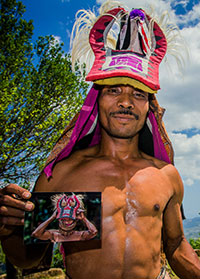 Together we will explore the extraordinary ancestral traditions of these islands where textiles are the predominant form of artistic expression, still playing a central role in every significant stage of life, especially marriage and death. Some islanders even remark that: ‘without cloth we cannot marry’.
Together we will explore the extraordinary ancestral traditions of these islands where textiles are the predominant form of artistic expression, still playing a central role in every significant stage of life, especially marriage and death. Some islanders even remark that: ‘without cloth we cannot marry’.
However change is underway in even the remotest villages and weavers are no longer passing on their skills to the next generation. We have a unique opportunity to witness a dying art form before it is gone forever.
.jpg)
We will enjoy the luxury of sailing effortlessly from island to island, crossing a rugged, isolated region where travel is normally a tough logistical nightmare.
Traveling aboard a graceful phinisi sailing schooner you will have access to villages and beaches that would otherwise be almost impossible to reach.
Along the way there will be time to enjoy the amazing volcanic scenery, meet local villagers, visit traditional markets, buy local textiles, swim and snorkel over colourful coral, relax and have fun. This is a fantastic, adventurous way to travel providing memories that passengers will treasure for the rest of their lives.
British expert textile guides, David and Sue Richardson, will be sailing with you and look forward to introducing you to each island, its people and its culture, sharing their knowledge through a series of evening talks.
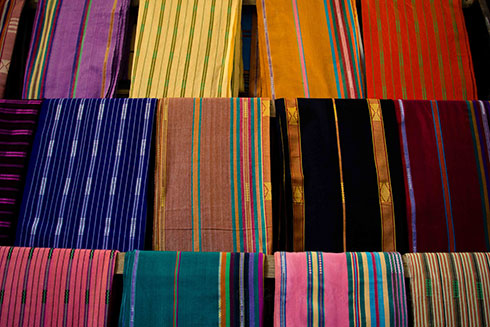
Itinerary
Maumere - Labuan Bajo
Expert Cruise Led by: David and Sue Richardson

Day 1
After arriving on the morning flight from Denpasar to Maumere via Waingapu you will be met at the airport and transferred to Maumere harbour to board the Ombak Putih in time for lunch. After everyone has settled into their cabins there will be a safety briefing while the ship sails out into the beautiful Bay of Maumere with the extinct volcano of Ile Kimang in the background. Dock at a nearby fishing village, built over the water on stilts, where we will experience the life of the local Bugis and Bajao sea gypsies. In the evening, relax over cocktails while David and Sue give an introductory talk about the culture and textiles of the local Sikka region before enjoying a welcome dinner on deck.
Day 2
Disembark close to Maumere for a short drive to the busy Wairkoja Friday market, where they sell local ikat and a variety of weaving supplies. Then drive up into the beautiful ‘Iwang Geté highlands to visit a small village where you will be welcomed with music and dancing. After gaining your first insights into the local techniques of spinning, binding, dyeing and weaving you will be able to purchase some of the finished textiles. If you are adventurous, you will be able to try betel nut, tobacco and locally distilled liquor. After lunch on board, the Ombak Puith will head out to Ledalero for a brief visit to the oldest museum on Flores, the Blikon Blewut Museum, to see the small collection of textiles from the Lesser Sunda Islands collected by Catholic missionaries in the 1950s and 60s. The final stop will be at a second Sikka village where you will see a different style of ikat, typical of the central Krowé region.
Day 3
In the morning the boat will sail past Larantuka, situated at the foot of the imposing Ile Mandiri volcano, and moor in a quiet bay for breakfast. As you go ashore, you will be welcomed by local Lamaholot villagers who will show you in detail how they produce their fantastic earthy-brown ikats decorated with small white seashells. After lunch, will moor close to a beach on the northern coast of Adonara Island for swimming and beachcombing.
Day 4
Arrive in Lembata and drop anchor on the north coast below the towering active volcano of Ile Api. Go ashore to see some of the superb ikat textiles produced in this region, meeting weavers from at least three neighbouring villages.
While you enjoy lunch, the boat will set sail for Jontona where you will be welcomed by dancers before climbing into trucks for the exhilarating drive up to the ancestral village, dramatically located on the side of the volcano. Here you will visit the various clan houses containing heirloom treasures such as elephant tusks and moko drums. Back down in the modern village a selling exhibition of textiles will give you the chance to add a fabulous bridewealth cloth to your collection.
Day 5
After sailing into Kalabahi Bay on Alor Island you will make an early start and head off through the island’s rugged landscape to the dramatically situated village of Takpala, occupied by Papuan people belonging to the local Abui tribe. Dressed in colourful local textiles, the villagers will entertain you with their delightful lego-lego circle dance, used to celebrate weddings and other life cycle events. Afterwards, explore their village market for local textiles, baskets and jewelry, and take a look inside their two-storey thatched houses which have an interesting architecture. Alor is very ethnically diverse so you might like to make a short stop at Kalabahi Museum to see the fine display of textiles and moko drums from across the island.
After a reviving lunch on board, drive up into the hills behind Kalabahi to the hamlet of Monbang, occupied by the Kabola people who have revived the previously widespread craft of making barkcloth. Dressed entirely in barkcloth, the villagers will welcome you before showing you how they turn tree bark into cloth. Samples of barkcloth will be available for purchase along with other textiles and baskets.
Day 6
This morning, sail into Labala Bay on the southern side of Lembata and go ashore at one of our favourite places, the unique whaling village of Lamalera, with its row of thatched boathouses lining the beach. The local weavers will be waiting for you in the village square to show you how they produce their stunning kewatek ikat sarongs, dyed with multiple immersions in indigo and morinda to produce an outstanding depth of colour. Later, walk up the hill to the upper half of the village to visit the church and see the view over the lower village.
Back on board the Ombak Putih, the whale hunters will demonstrate the hazardous techniques they use to harpoon the sperm whales from their small outriggers. After making farewells, the Ombak Putih will set sail due south across the Savu Sea towards Kupang in West Timor.
Day 7
After disembarking at the colourful old harbour where Captain Bligh landed in 1789, drive a short distance to the Museum of Nusa Tenggara Timur, which has a fine collection of textiles and other artefacts from across the Lesser Sunda Islands. Then head south through beautiful scenery into the territory of the Amarasi tribe, to be escorted to a reception by the King and Queen of the Amarasi in their Royal Pavilion. An accomplished artist himself, the King is justifiably proud of the culture and textiles of his people and after a dance performance you will be shown examples of local weavings which will be available for purchase. There should also be time to visit a small weaving cooperative before returning to the boat for lunch. In the afternoon we will visit a nearby village occupied by members of the Helong tribe who will give an excellent demonstration of indigo and morinda dyeing before offering a selection of their ikats to buy. Tonight set sail to the tiny remote island of Savu.
Day 8
In the morning, go ashore at Napae Bay where Captain Cook moored HMS Endeavour on his way home after his expedition to Australia. A very scenic drive in trucks will bring you to the next group of weavers who live in a small hilltop village with spectacular views down to the coast. These master dyers and weavers will demonstrate how they spin, bind and dye their cotton before weaving their distinctive ikat tube-skirts, referred to locally as ei. Designs differ depending on the tribal affiliation of the weaver. After exploring the village, including the ritual clan house where the heirloom baskets for textiles are kept, there will be time to select from a colourful selling exhibition of textiles. The men will demonstrate how they climb the tall lontar palms to tap their delicious juice. After lunch on board, go ashore again – this time to be welcomed on the beach by local dancers and ikat-clad horsemen. This afternoon’s destination is the ritual village of Namata, where priests of the ancestral Jingi tiu religion use megalithic stone platforms to conduct rituals and sacrifices. After a performance of traditional dancing, return to the boat for a second overnight crossing of the Savu Sea to reach thesouthern coast of Flores.
Day 9
Back in the land of volcanoes! Make land in a bay at the foot of Gunung Inierie for a spectacular drive up a steep gorge to visit two isolated villages occupied by the Ngada tribe, which in this region live in a matrilineal society. The first stop is the dramatically situated village of Gurusina, with thatched houses decorated with buffalo horns surrounding an open square containing male and female shrines and megalithic altars. Continue to Bena where you will see women weaving on their front porches as well as displays of textiles hung out for sale. After lunch in the bay you may enjoy a refreshing swim before returning back across the Savu Sea for the first of two days in East Sumba, one of the most important weaving regions in the Lesser Sunda Islands.
Day 10
Arriving on the eastern coast of Sumba, land on the sandy beach at Melolo where local buses will take you to the village of Umabara, with its tall thatched houses and megalithic carved tombs, and the nearby Royal hamlet of Pau. This area is famous for its exquisite supplementary warp weaving, known locally as pahikung. Some of the finest practitioners are two local princesses who will show examples of their work. The next destination is the Royal village of Parai Yawangu, renowned for the quality of its warp ikat. With its traditional houses and a magnificent line of tombs, it remains the seat of the Raja of Rindi. Enjoy lunch back on board while the Ombak Putih sails north to Waingapu. On the way she will moor close to a beach where you can enjoy an afternoon swim or snorkel.
Day 11
Depart the harbour to visit a small workshop which produces some of the highest quality ikat hinggi to be found on the island. Here you will see how the designs are created and transferred onto the warps and will begin to comprehend the laborious process of binding that is necessary to produce such spectacular and intricately patterned cloths. A superb collection of ikat will be available to buy before setting off to explore the neighbouring Royal village of Prailiu on foot. You will no doubt be accosted by eager textile sellers at every turn.
The vehicles will drive you out of town through paddy fields to a rarely visited weaving village to be greeted by ikat-clad warriors on horseback. Sitting in the shade on the veranda of a traditional house you will be entertained by a selection of traditional dances before trying to make your selection from a magnificent display of ikat, baskets and beads. On the way back to the harbour, make a stop at the cathedral to see the statue of Christ dressed in Sumbanese ikat.
As you relax over a late lunch, the boat will set sail for Rinca. Guests are invited to dress lavishly in their finest ikat cloths for tonight’s farewell party and dinner with the captain and crew, who will entertain all the guests on deck with traditional Indonesian songs and dances.
Day 12
On the final morning the Ombak Putih will moor close to the starkly beautiful island of Rinca for an early breakfast followed by a short visit to Komodo National Park led by a Park Ranger. No textiles here, just amazing ten-foot long Komodo dragons! Back on board, sail to the final destination, the port of Labuan Bajo where you will have lunch before transferring to the nearby airport for the afternoon flight to Denpasar.
The Ombak Putih
 The Ombak Putih is an almost traditional Pinisi sailing schooner, furnished to a high standard, and offering 12 double air-conditioned cabins, each with its own private bathroom.
The Ombak Putih is an almost traditional Pinisi sailing schooner, furnished to a high standard, and offering 12 double air-conditioned cabins, each with its own private bathroom.
The ship's main deck is dominated by a 25m tall mainmast and a large deck table where you can have dinner under the stars. On the deck house level on the aft side of the boat, a spacious sun deck (with canopy for some shade) overlooks the sea. Here you can read in a comfortable deck chair or dream away on one of the comfortable day beds.
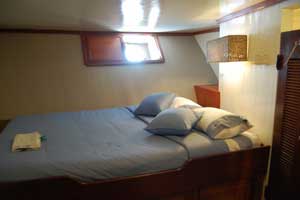 Accommodation is below decks, where you will find twelve cabins, four with double beds and eight configured as twin-bunks. Unlike typical ship accommodation, your cabin provides ample space to store your stuff and still move about with ease. All cabins are air-conditioned (individually controlled) and have private bathrooms with warm and cold water.
Accommodation is below decks, where you will find twelve cabins, four with double beds and eight configured as twin-bunks. Unlike typical ship accommodation, your cabin provides ample space to store your stuff and still move about with ease. All cabins are air-conditioned (individually controlled) and have private bathrooms with warm and cold water.
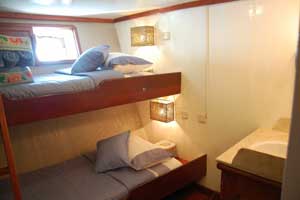 The Ombak Putih is a mix of traditional and modern design. Her hull and rigging are traditional, while the deck house and interior were custom designed to adapt to Western tastes of space, privacy and comfort. While Indonesian traditional sailing vessels are customarily referred to as Bugis Schooners, strictly speaking she is rigged as a Ketch, the foremast being higher than the aft mast.
The Ombak Putih is a mix of traditional and modern design. Her hull and rigging are traditional, while the deck house and interior were custom designed to adapt to Western tastes of space, privacy and comfort. While Indonesian traditional sailing vessels are customarily referred to as Bugis Schooners, strictly speaking she is rigged as a Ketch, the foremast being higher than the aft mast.
Specifications and Deck Plans
 Construction: Kalimantan, Indonesia, 1996/7
Construction: Kalimantan, Indonesia, 1996/7
Registry: Indonesia
Length over all : 36 meters (118 feet)
Beam: 10 meters (33 feet)
Draft: 3.5 meters (11.5 feet)
Decks: 1 main deck, 1 sun deck, 1 cabin deck
Motor: Detroit Diesel, 8 cylinder
Sails: 2 masts, 7 sails, total 600 square meters
Max. speed: 10-12 knots under sail
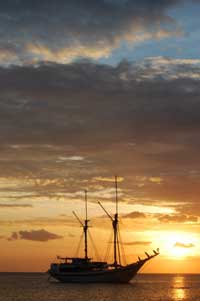 Crew: 16 (Indonesians), 1 European cruise director
Crew: 16 (Indonesians), 1 European cruise director
Capacity: 12 cabins for 24 passengers
Safety: inflatable life rafts, life buoys, life jackets
Navigation: radar, GPS, depth sounder
Voltage: 220 Volt
Tenders: 2 (with 60 and 25 HP outboards)
Safety and Seaworthiness
The vessel is fitted with all internationally required safety equipment such as SSB and VHF radios, life jackets, life rafts, and satellite telephone. Experienced navigators consider it an axiom that the seaworthiness of a vessel depends on the seaworthiness of the crew. Our ship has a well trained and well seasoned Indonesian crew of sixteen, complemented by a multilingual European Cruise Director. We are proud of the fact that most of the crewmembers that joined us when the vessel was launched are still on board today.
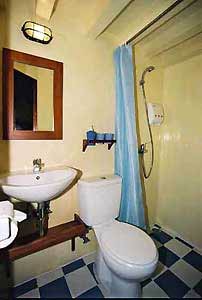 Services Profile
Services Profile
• Spacious twin shared cabin with twin bunk beds or double bed
• Each cabin has a private bathroom with toilet and hot shower
• Washbasin and soap toiletries in your cabin
• Cabins have individually controlled air conditioning
• Towels and beach towels that are regularly changed
• Valuables and travel documents can be stored in the ship's safe
• Dining in spacious air conditioned lounge
• Teak wooden furniture in lounge, cabins and on deck
• Spacious sun and semi-covered decks
• Free tea, coffee and mineral water
• Excellent food and snacks (vegetarian food on request)
• Excellent wine selection, cold beer and other alcoholic drinks for sale
• Fresh water on-deck shower
• Chilled towels and a welcome drink upon arrival
• Outdoor sleeping facilities
• Professional European cruise director
• Main tender with 60 hp. outboard engine takes 24 passengers
• Auxiliary tender with 25 hp. outboard takes 10 passengers
• Unlimited use of our snorkeling equipment and 2 sea canoes
• Organize scuba diving in Komodo National Park (optional)
• Television, VCD and music centre in lounge
.jpg)


